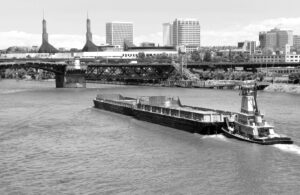Let’s say that you’ve had some early success with your barge transport company, and that you feel you are ready to scale your operations. There is a lot to do: You’ll need to integrate the right systems, processes, technology, and partners that will help you succeed.
At the same time, scaling your barge transport business requires determining what’s working and what’s not in your current operations—that way, you can plan for the changes needed for continued success.
The following best practices outline what these steps look like so you can strategize and scale a barge transport business.
Have a Clear Idea of What Success Looks Like, And Develop a Strategy to Achieve It
Research what other successful barge transport businesses have done to scale their barge transport business, and model it. For instance, Canal Barge Company of New Orleans was founded in 1933 with one barge and now owns and operates a fleet of over 800 barges. They transport valuable liquid, dry, and deck cargoes to destinations in North America, Central and South America, the Caribbean, and across the Atlantic Ocean. Canal attributes their success to:
- Fostering solid, family-like relationships with industry partners. They have deep ties with local, regional, and national mariners and shore businesses, and have trusted the same bank for over half a century.
- Investing significant funding in mariner training initiatives. They “hire for attitude and train for skill,” which has resulted in a strong foundation of ready, loyal and supportive employees and operators.
- Nurturing a rapport with the local community. Canal takes part in the New Orleans Business Council, is actively involved in flood protection initiatives for the city, and is actively devoted to driving a culture of entrepreneurship in New Orleans.
Bayou Fleet is another great example of a company who wanted to expand their business significantly and developed a strategy that helped them do it. The Hahnville, Louisiana-based company was founded in 1982 and up until a couple of years ago was still using manual processes to run their operations. They turned to BargeOps for automated solutions which helped them deliver faster responses to customer requirements, achieve more detailed location tracking capabilities, reduce the time it takes to deliver customer invoices, and grow their business to record levels.
What are other businesses like yours doing to build relationships with industry partners, employees, and municipalities? What proactive steps can you take to move your business forward?
Use Data and Analytics to Set, Measure, and Achieve Goals
While data and analytics are crucial for identifying problems with your operations, they are useless if you aren’t using results to make improvements that will help scale your barge transport business. A clearly defined analytics strategy should correlate all of the data you collect with your business goals, essentially moving your company from reactive to proactive.
To create a successful analytics strategy:
- Define your strategic initiatives. What are the KPIs that define success for your company? Where do you want to see success or growth? What specific metrics will show you that your business has succeeded? With a clear idea of what you’re trying to achieve with your data, key players can get on board and have a unified vision.
- Identify challenges or risks. What roadblocks might your company face when collecting analytics? One major challenge is how to integrate current IT roles and processes with a new data strategy. Who should have access to the raw data? How can a secure environment be ensured? By addressing these questions related to data governance, you can mitigate unexpected challenges.
- Start small, but plan for future changes. Small introductions of data visualization are less overwhelming and can prove what might be beneficial in a company-wide analytics strategy. Identify a team or two that could benefit from using an analytics dashboard that will streamline their workflow. Then, figure out how to gradually apply the technology across the business.
BargeOps supports our customers’ proactive growth by building in a clear analytics strategy and making visual, useful analytics readily available using Tableau, a powerful data analytics and data visualization platform. Additionally, the BargeOps Analytics module transforms your business by providing the information you need to make better decisions about everything: Optimizing the revenue from your assets, improving the efficiency of your operations, and lowering your overall costs.
Here are just a few examples of what the module can do:
- When river conditions change, you can see how that will impact barge movement, and adjust your tow boats available to meet the current demand.
- When a barge is shifted, moved, cleaned, or repaired, it all shows up as data that will allow crew members to make better decisions.
- If you move a barge from Point A to Point B and multiple boats work with that barge, BargeOps Analytics will determine how to allocate the revenue earned among the boats.
- Events such as lock delay time, shifts between O/D pairs, midstream-in/out times, fleeting days, state taxes by river segment, and more can be analyzed to streamline your operation.
- Examining the average barge revenue per trip day, barge trip average duration, and other measures such as total miles, load miles, empty miles, total shifts, total delays, etc. can deepen your understanding of barge profitability.
In your current operations, do you know how much time each barge spends working? Which barges are generating the most revenue? How much downtime each piece of equipment is having? How much time is lost in lock delays? If you can capture that data, it can then be optimized to improve your operations — allowing you to work on growing your business.

Begin to Automate Key Procedures
While fully automated waterway shipping seems light years away, new innovations are being introduced to automate at least some operations in the barge transport business. For example, barges are becoming equipped with onboard automated cranes to transfer containers while at port, and small ports along inland waterways offer automated transfer of containers between waterway and road vehicles. Integrating or at least planning for some of this automated technology can allow you and your crew members to focus on other areas that require your attention.
Other automated options to look into include:
Sailing
- Assisted sailing uses an adaptive track controller or track pilot to allow the skipper to define the vessel’s track and speed on longer journeys (think cruise control). The skipper still maneuvers in harbors and near quays, as well as any time situations with traffic or unexpected events take place.
- Partial automation combines adaptive track controllers with sensors for speed adjustments that can be made from a skipper’s smartphone. If human control is required, an alarm will sound to let the skipper know.
- Conditional automated navigation allows the ship to follow a track that takes into account other ship traffic, the environment, and objects in the relevant environment. The track controller adapts the track if needed, and doesn’t require much human interaction on board.
- High automation means the ship and its systems are monitored from shore as a track controller and sensors do the work onboard. Changes can be made at the control center when needed. This level of autonomous sailing requires a high level of security (confidentiality, integrity and availability) and training.
Data Entry and Reporting
Billing and invoicing take a lot of time that could be spent on other tasks. Electronic management of freight contracts, ticketing, and invoicing eliminates having to manually send emails to clients, enter data into spreadsheets, and keep track of invoices.
By using software like BargeOps, you can streamline the contract and billing process. Our Freight Contract Management program allows you to set electronic terms and pricing for various shipping origins and destinations by commodity. When a barge ticket is created referencing a contract number, the correct pricing and terms for that contract will be automatically reflected on that ticket and carried forward accurately for invoicing.
BargeOps Onshore automates the capture of activities like mid-streaming a barge into the fleet, keeping track of how long it’s in the fleet, and then invoicing the customer when it moves out of the fleet. It also records your loading, unloading, shifting and daily fleeting charges as they occur and retains this information in the Barge Ticket Detail.
And instead of trying to remember if you sent an invoice to a client via email or snail mail, BargeOps shows how each bill was sent, and how many times it was sent. Invoice data can also be filtered by customer, sent date range, invoice date range, and invoice number range, eliminating much of your daily administrative hassle so you can focus on growing your business.
Inventory Management
When ports are inefficiently managed and containers pile up, incoming barges get stuck in traffic jams that throw the entire fleet schedule off. To prevent chaos and speed the loading and unloading process along, you can use inventory management software like BargeOps Terminal. Information about the customer, components of the inventory, and the intermodal transfer method is all tracked, allowing you to set up billing for all of these functions under one contract.
Improve Communication Methods and Ensure They are Secure
The digital shift in the maritime industry is real. Along with making efforts to automate procedures for more efficient operations in your growing business, you will have to take strides to update communication methods that support those changes.
First, consider using BargeOps Onboard to enable a seamless exchange of information between shore based dispatch and boats. Instead of the dispatcher having to call orders to the vessel over the radio, they can easily enter instructions into BargeOps. The captain can see what to do and any info about the order will go back to the shore automatically. Best of all, it keeps a complete electronic deck log to keep everyone on the same page.
Second, and most importantly, as sensitive material is shared over air, you must take measures to prevent cyberattacks. Running the ship-shore communications through (virtual) private networks, setting up firewalls and gateways, and monitoring and analyzing network traffic can help. However, using proper cybersecurity practices will also need to be followed by the operators. This means establishing strict role-based permissions regarding contract data, finances and more. BargeOps requires permission to access every screen of information.
BargeOps Would Love to Help You Scale Your Barge Transport Business
While we can’t make your boats sail autonomously or define your goals for the future, BargeOps does offer many tools that can help your business run more efficiently. By using our software to take some of the daily time-consuming tasks off of your hands, you’ll have more time to focus on what it takes to expand your barge transport business. Contact us today to discover how we can help.


